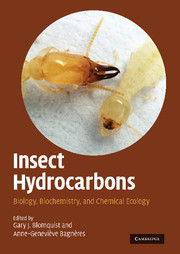Book contents
- Frontmatter
- Contents
- List of contributors
- Foreword
- Acknowledgments
- Part I Chemistry, Biochemistry, and Physiology
- 1 Introduction: history and overview of insect hydrocarbons
- 2 Structure and analysis of insect hydrocarbons
- 3 Biosynthesis of cuticular hydrocarbons
- 4 Molecular biology and genetics of hydrocarbon production
- 5 Site of synthesis, mechanism of transport and selective deposition of hydrocarbons
- 6 Cuticular lipids and water balance
- 7 Chemical taxonomy with hydrocarbons
- 8 Chemical synthesis of insect cuticular hydrocarbons
- 9 Oxygenated derivatives of hydrocarbons
- Part II Chemical Communication
- Index
7 - Chemical taxonomy with hydrocarbons
from Part I - Chemistry, Biochemistry, and Physiology
Published online by Cambridge University Press: 18 May 2010
- Frontmatter
- Contents
- List of contributors
- Foreword
- Acknowledgments
- Part I Chemistry, Biochemistry, and Physiology
- 1 Introduction: history and overview of insect hydrocarbons
- 2 Structure and analysis of insect hydrocarbons
- 3 Biosynthesis of cuticular hydrocarbons
- 4 Molecular biology and genetics of hydrocarbon production
- 5 Site of synthesis, mechanism of transport and selective deposition of hydrocarbons
- 6 Cuticular lipids and water balance
- 7 Chemical taxonomy with hydrocarbons
- 8 Chemical synthesis of insect cuticular hydrocarbons
- 9 Oxygenated derivatives of hydrocarbons
- Part II Chemical Communication
- Index
Summary
Comparative chemistry is an old discipline originally designed to “use chemistry to name and classify plants”. The first reports appeared in 1960, and there has been a steady stream ever since (see Reynolds, 2007 for review). Although plants have been the most studied chemotaxonomy, many researchers have applied the same approach to invertebrates, especially insects.
One of the most widely studied chemotaxonomic characters in insects has been cuticular hydrocarbons (CHCs). The earliest descriptive papers on CHCs were by Jackson (1970), Jackson and Bayer (1970), Jackson and Blomquist (1976), Lockey (1976), and Lange et al.(1989). Carlson and collaborators (Carlson and Service 1979, 1980; Carlson et al., 1978; Carlson, 1988) were the first to recognize the special role of CHCs in chemical taxonomy. Since then, numerous reviews have devoted sections to CHCs (Lockey, 1980, 1988; Howard and Blomquist, 1982, 2005; Blomquist and Dillwith, 1985; Blomquist et al., 1987; Kaib et al., 1991; Singer, 1998; Howard, 1993). Since the introduction of molecular techniques, the number of insect chemotaxonomy papers about hydrocarbons has dropped, but there are still many submissions and publications. Explanations for this continued interest in insect CHCs include not only their importance as chemical cues in recognition processes, but also the fact that insects are excellent bioindicators of nature conservation, and inversely, pests to control.
- Type
- Chapter
- Information
- Insect HydrocarbonsBiology, Biochemistry, and Chemical Ecology, pp. 121 - 162Publisher: Cambridge University PressPrint publication year: 2010
- 41
- Cited by



